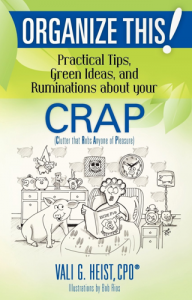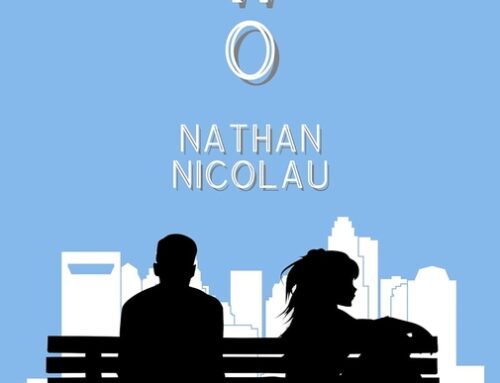 Comedian George Carlin pointed out that “A house is just a place to keep your stuff while you go out and get more stuff.” In recent years it seems that the average American single-family house (a house that has grown from under a thousand square feet in 1950 to over 2000 square feet in recent decades) is no longer big enough keep all that stuff while we are out buying more. According to the Self Storage Association, there are currently over 50,000 self-storage facilities in the United States. Most of these rental units are used to store the overflow from single-family homes. Americans have a lot of stuff, and don’t seem to be particularly eager to get rid of it, even though they are tripping over it, losing it, paying to store it, and all too often letting it interfere with their enjoyment of their homes and lives. Enter Vali G. Heist. Heist is a certified professional organizer. Her book, Organize This!, aims to help us rescue ourselves from the clutches of our belongings.
Comedian George Carlin pointed out that “A house is just a place to keep your stuff while you go out and get more stuff.” In recent years it seems that the average American single-family house (a house that has grown from under a thousand square feet in 1950 to over 2000 square feet in recent decades) is no longer big enough keep all that stuff while we are out buying more. According to the Self Storage Association, there are currently over 50,000 self-storage facilities in the United States. Most of these rental units are used to store the overflow from single-family homes. Americans have a lot of stuff, and don’t seem to be particularly eager to get rid of it, even though they are tripping over it, losing it, paying to store it, and all too often letting it interfere with their enjoyment of their homes and lives. Enter Vali G. Heist. Heist is a certified professional organizer. Her book, Organize This!, aims to help us rescue ourselves from the clutches of our belongings.
As the book’s subtitle, Practical Tips, Green Ideas, And Ruminations About Your CRAP (Heist defines CRAP as “clutter that robs anyone of pleasure”) suggests, this book offers far more than tips about organizing your space, though it has plenty of those as well. Heist writes thoughtfully about the cultural reasons for buying so much stuff and the psychological issues that keep us from getting rid of it when it is no longer useful or has become burdensome.
It would be easy to take a hectoring, self-righteous tone in a book like this, particularly considering the environmental and social consequences of our consumerist society. Heist doesn’t sugarcoat the problem. In fact, she delivers some painful statistics, such as the fact that Americans constitute five percent of the world’s population yet use 30 percent of its resources. Nonetheless, Heist’s tone is kind, even compassionate.
As you might expect from this description, a great deal of the book’s message is less about how to organize stuff than how to get rid of it and stop bringing ever more of it into your home. In that respect the book is a bit repetitive at times. There are only so many ways to say “get rid of stuff you don’t need or want anymore.” However, Heist does counsel readers about how to bring themselves around to letting go. She suggest that you give family heirlooms to children now rather than waiting until you die; she gently points out that giving away the furniture of dear, departed Grandmother does not mean you didn’t love her; and she gives us all permission to dispose of gifts we received but do not care for.
Heist does eventually get down to the practical matters of organization—talk of storage boxes and peg boards and file folders. Some of the tips and suggestions seem a little obvious. Do I really need to be told that I should write the contents on the outside of storage containers? Or that I should break the task of organizing an entire house into small parts? Well, maybe. If you need to read this book at all you probably need to hear those tips, even if after reading them you suspect you could have figured it out yourself.
On the other hand, some of her suggestions, such as the counsel to “resist dumping” (in other words, to put things away as soon you get home with them) or to not postpone decision making (who among us hasn’t stuffed things in a box to go through later, and then kept but never again opened the box?), are brilliant in their simplicity and, I suspect, their power to actually make a difference in the state of our living spaces. She also provides plenty of helpful resources: books, links, info about where to take charitable donations, where to recycle electronics, and so on.
In addition to chapters on organizing the kitchen, cleaning out the garage, and so on, Heist goes a bit further afield and includes chapters on organizing for travel, preparing for the birth of a baby (including how to keep track of doctors’ appointments and the list of whom to call when the baby arrives), how to organize materials for filing taxes and applying to college, and even how to enjoy the holidays in a simpler, less frantic way.
If you are drowning in clutter, this book won’t take you by the hand and solve the problem for you. What it will do is help you think through the mental obstacles and recognize the physical obstacles to reducing that clutter and making your life more peaceful. Despite the nuts-and-bolts information, this book is subtle and about far more than how to arrange your belongings in the most efficient manner. As Heist says, “The physical clutter that exists in our outer world is a reflection of our inner mental world . . .” Heist wisely addresses the inner world before she begins tossing and sorting belongings.
Links
Get an Editorial Review | Get Amazon Sales & Reviews | Get Edited | Publish Your Book | Enter the SPR Book Awards | Other Marketing Services






















Hi Avery! Thanks so much for the review. After eight years of being a professional organizer you would be surprised how many people don’t know what’s in their unmarked boxes! I appreciate your thoughtful review. All the best! Vali